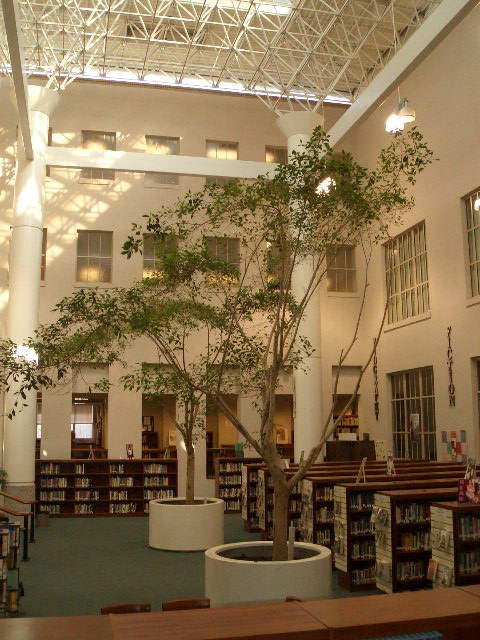|
Cavaedium
''Cavaedium'' or atrium are Latin names for the principal room of an ancient Roman house, which usually had a central opening in the roof (''compluvium'') and a rainwater pool (''impluvium'') beneath it. The ''cavaedium'' passively collected, filtered, stored, and cooled rainwater. It also daylit, passively cooled and passively ventilated the house. The atrium was the most important room of the ancient Roman house. The main entrance led into it; patrones received their clientes there, and marriages, funerals, and other ceremonies were conducted there. In earlier and more modest homes, the atrium was the common room used for most household activities; in richer homes, it became mainly a reception room, with private life moving deeper into the (larger) house. The atrium was generally the most elaborate room, with the finest finishings, wall paintings, and furnishings. The atrium was entered either through a shop or by a straight, narrow passage from the street. The smaller, ... [...More Info...] [...Related Items...] OR: [Wikipedia] [Google] [Baidu] [Amazon] |
Atrium (architecture)
In architecture, an atrium (: atria or atriums) is a large open-air or skylight-covered space surrounded by a building. Atria were a common feature in Ancient Roman dwellings, providing light and ventilation to the interior. Modern atria, as developed in the late 19th and 20th centuries, are often several stories high, with a glazed roof or large windows, and often located immediately beyond a building's main entrance doors (in the lobby). Atria are a popular design feature because they give their buildings a "feeling of space and light." The atrium has become a key feature of many buildings in recent years. Atria are popular with building users, building designers and building developers. Users like atria because they create a dynamic and stimulating interior that provides shelter from the external environment while maintaining a visual link with that environment. Designers enjoy the opportunity to create new types of spaces in buildings, and developers see atria as prestigi ... [...More Info...] [...Related Items...] OR: [Wikipedia] [Google] [Baidu] [Amazon] |
Domus
In ancient Rome, the ''domus'' (: ''domūs'', genitive: ''domūs'' or ''domī'') was the type of town house occupied by the upper classes and some wealthy freedmen during the Republican and Imperial eras. It was found in almost all the major cities throughout the Roman territories. The modern English word '' domestic'' comes from Latin ''domesticus'', which is derived from the word ''domus''. Along with a ''domus'' in the city, many of the richest families of ancient Rome also owned a separate country house known as a villa. Many chose to live primarily, or even exclusively, in their villas; these homes were generally much grander in scale and on larger acres of land due to more space outside the walled and fortified city. The elite classes of Roman society constructed their residences with elaborate marble decorations, inlaid marble paneling, door jambs and columns as well as expensive paintings and frescoes. Many poor and lower-middle-class Romans lived in crowded, d ... [...More Info...] [...Related Items...] OR: [Wikipedia] [Google] [Baidu] [Amazon] |
Compluvium
''Cavaedium'' or atrium are Latin names for the principal room of an Domus, ancient Roman house, which usually had a central opening in the roof (''compluvium'') and a rainwater pool (''impluvium'') beneath it. The ''cavaedium'' passively collected, filtered, stored, and cooled rainwater. It also Daylighting (architecture), daylit, Passive cooling#Preventive techniques, passively cooled and passive ventilation, passively ventilated the house. The Atrium (architecture), atrium was the most important room of the ancient Roman house. The main entrance led into it; Patronage in ancient Rome, patrones received their clientes there, and Weddings in ancient Rome, marriages, Roman funerary practices, funerals, and other ceremonies were conducted there. In earlier and more modest homes, the atrium was the common room used for most household activities; in richer homes, it became mainly a reception room, with private life moving deeper into the (larger) house. The atrium was generally the ... [...More Info...] [...Related Items...] OR: [Wikipedia] [Google] [Baidu] [Amazon] |
Patronage In Ancient Rome
Patronage (''clientela'') was the distinctive relationship in Social class in ancient Rome, ancient Roman society between the ''patronus'' ('patron') and their ''cliens'' ('client'). Apart from the patron-client relationship between individuals, there were also client kingdoms and tribes, whose rulers were in a subordinate relationship to the Roman state. The relationship was hierarchical, but obligations were mutual. The patron was the protector, sponsor, and benefactor of the client; the technical term for this protection was ''patrocinium''. Although typically the client was of inferior social class, a patron and client might even hold the same social rank, but the former would possess greater wealth, power, or prestige that enabled him to help or do favors for the client. From the emperor at the top to the commoner at the bottom, the bonds between these groups found formal expression in legal definition of patrons' responsibilities to clients. Patronage relationships were n ... [...More Info...] [...Related Items...] OR: [Wikipedia] [Google] [Baidu] [Amazon] |
Marcus Terentius Varro
Marcus Terentius Varro (116–27 BCE) was a Roman polymath and a prolific author. He is regarded as ancient Rome's greatest scholar, and was described by Petrarch as "the third great light of Rome" (after Virgil and Cicero). He is sometimes called Varro Reatinus ("Varro of Rieti") to distinguish him from his younger contemporary Varro Atacinus ("Varro of Atax"). Biography Varro was born in or near Reate (now Rieti in Lazio) into a family thought to be of equestrian rank. He always remained close to his roots in the area, owning a large farm in the Reatine plain (reported as near Lago di Ripasottile,) until his old age. He supported Pompey, reaching the office of praetor, after having served as tribune of the people, '' quaestor'' and '' curule aedile''. It is probable that Varro was discontented with the course on which Pompey entered when the First Triumvirate formed 60 BC, and he may thus have lost his chance of rising to the consulship. He actually ridiculed th ... [...More Info...] [...Related Items...] OR: [Wikipedia] [Google] [Baidu] [Amazon] |
Peristyle
In ancient Ancient Greek architecture, Greek and Ancient Roman architecture, Roman architecture, a peristyle (; ) is a continuous porch formed by a row of columns surrounding the perimeter of a building or a courtyard. ''Tetrastoön'' () is a rarely used archaic term for this feature. The peristyle in a Greek temple is a ''peristasis (architecture), peristasis'' (). In the Christian Church architecture, ecclesiastical architecture that developed from the Roman basilica, a courtyard peristyle and its garden came to be known as a cloister. Etymology The Greek word περίστυλον ''perístylon'' is composed of περί ''peri'', "around" or "surrounded", and στῦλος ''stylos'', "column" or "pillar", together meaning "surrounded by columns/pillars". It was Latinised into synonyms ''peristylum'' and ''peristylium''. In Greek architecture A peristyle was mostly used as a courtyard in Ancient Greece, but in the homes of people who were in the upper class or if they owned s ... [...More Info...] [...Related Items...] OR: [Wikipedia] [Google] [Baidu] [Amazon] |
Roman Villa
A Roman villa was typically a farmhouse or country house in the territory of the Roman Republic and the Roman Empire, sometimes reaching extravagant proportions. Nevertheless, the term "Roman villa" generally covers buildings with the common features of being extra-urban (i.e. located outside urban settlements, unlike the ''domus'' which was inside them) and residential, with accommodation for the owner. The definition also changed with time: the earliest examples are mostly humble farmhouses in Italy, while from the Roman Republic, Republican period a range of larger building types are included. Typology and distribution The present meaning of "villa" is partially based on the fairly numerous ancient Roman written sources and on archaeological remains, though many of these are poorly preserved. The most detailed ancient text on the meaning of "villa" is by Varro (116–27 BC) dating from the end of the Republican period, which is used for most modern considerations. But R ... [...More Info...] [...Related Items...] OR: [Wikipedia] [Google] [Baidu] [Amazon] |
House Of Menander
The House of Menander (Italian: Casa del Menandro) is one of the richest and most magnificent houses in ancient Pompeii in terms of architecture, decoration and contents, and covers a large area of about occupying most of its '' insula''. Its quality means the owner must have been an aristocrat involved in politics, with great taste for art. The house was excavated between November 1926 and June 1932 and is located in Region I, Insula 10, Entrance 4 (I.10.4) of the city. Description The oldest part of the house consists of a relatively modest atrium with immediately surrounding rooms built in 250 BC. About 100 years later the '' domus'' was modernised; tuff capitals were used for the entrance door and the '' tablinum''. In the Augustan period the ''domus'' was substantially modified; a peristyle was built using the space from the demolition of the adjacent residential buildings. In the space to the west, elaborately decorated thermal baths were created, centred around a s ... [...More Info...] [...Related Items...] OR: [Wikipedia] [Google] [Baidu] [Amazon] |
Etymology
Etymology ( ) is the study of the origin and evolution of words—including their constituent units of sound and meaning—across time. In the 21st century a subfield within linguistics, etymology has become a more rigorously scientific study. Most directly tied to historical linguistics, philology, and semiotics, it additionally draws upon comparative semantics, morphology, pragmatics, and phonetics in order to attempt a comprehensive and chronological catalogue of all meanings and changes that a word (and its related parts) carries throughout its history. The origin of any particular word is also known as its ''etymology''. For languages with a long written history, etymologists make use of texts, particularly texts about the language itself, to gather knowledge about how words were used during earlier periods, how they developed in meaning and form, or when and how they entered the language. Etymologists also apply the methods of comparative linguistics to reconstruct in ... [...More Info...] [...Related Items...] OR: [Wikipedia] [Google] [Baidu] [Amazon] |
Alae (architecture)
Ala, ALA, Alaa, or Alae may refer to: Codes * Åland Islands, ISO 3166-1 alpha-3 code * Åland, ISO 3166-1 country code * Former NYSE stock symbol of Alcatel; see Alcatel-Lucent * Almaty International Airport, IATA code Military * , a US Navy tugboat * Ala (Roman allied military unit), a Republican-period, largely infantry, formation of 5,400 men * Ala (Roman cavalry unit), an Imperial-period, purely cavalry, formation of 500 men * American Legion Auxiliary * Arab Liberation Army * Arakan Liberation Army Mythology and religion * Ala (demon), a female demon in Serbian mythology * Ala (Luwian goddess), a Hittite and Luwian goddess * Ala (Odinani), an Alusi (deity) in the Odinani beliefs of the Igbo people of Nigeria Organizations * African Leadership Academy * Alleanza Liberalpopolare – Autonomie, an Italian political party * Allgemeine Anzeigen GmbH * American Latvian Association * American Leadership Academy * American Legion Auxiliary * American Library Associatio ... [...More Info...] [...Related Items...] OR: [Wikipedia] [Google] [Baidu] [Amazon] |





